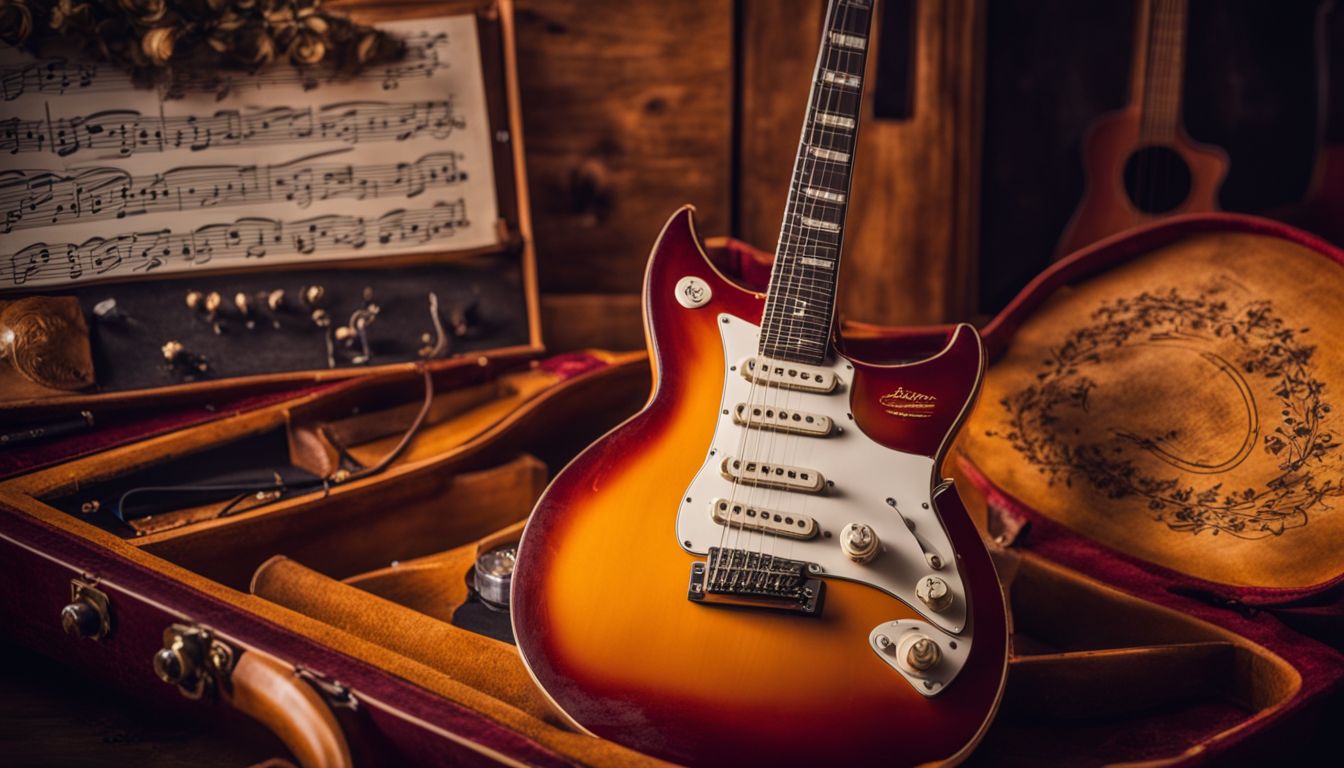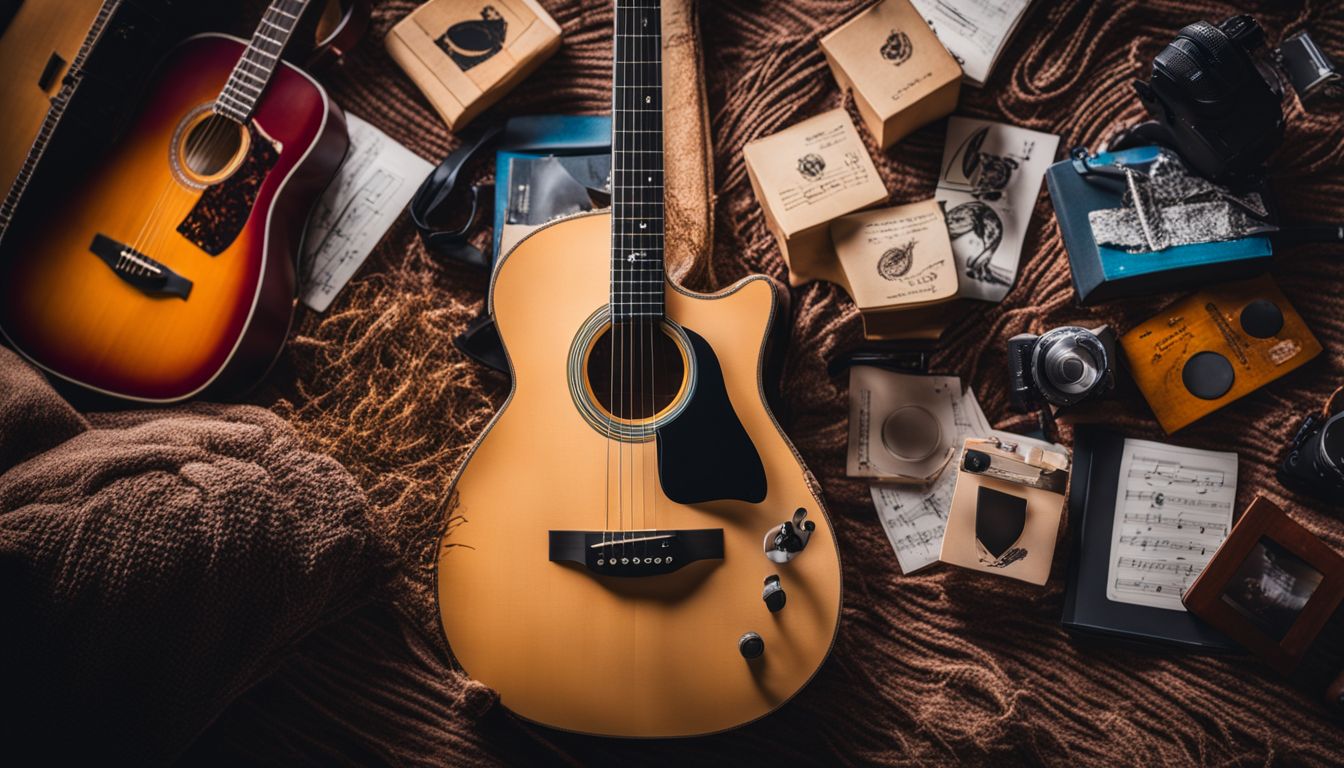Can I Learn Guitar in 3 Months? Learn the Secret Formula for Shredding on Guitar in Only 12 Weeks
Ever found yourself dreaming about strumming a guitar like a rockstar, but you only have 3 months to master it? Trust me, I’ve been in those shoes too. It was a challenging, yet thrilling journey of exploring the best tunes, managing the toughest strums, and weaving chords into beautiful melodies within just 90 days! This article isn’t just my narrative; it’s full of practical strategies and profound insights that can help transform your learning process into an exciting ride.
So let’s dive straight in to unravel the mystery behind quick mastering and delivering stand-out performances on guitar!
Key Takeaways
- Dedication, consistency, and effective practice techniques are key to learning guitar in just three months.
- Practice for at least 15 minutes daily, focusing on quality over quantity.
- Incorporate constructive criticism into your learning journey to refine your technique and improve your skills.
- Set realistic goals, stay motivated during challenging moments, and enjoy the process of becoming a skilled guitarist.
Is it Possible to Learn Guitar in Three Months?
Yes, you can learn the basics of guitar in three months. The secret lies in your practice length, quality, and consistency. Even a daily commitment of as little as 15 minutes can lead to substantial progress if done with dedication.
Understand that it’s not just about strumming for hours aimlessly, but focusing on techniques and areas you find challenging.
Developing rhythm plays a crucial role in playing any instrument, including the guitar. Using tools like metronomes or drum machines will help maintain timing while practicing scales and songs.
Additionally, remember that short yet frequent practice sessions prove more effective than long rare ones. It gives your brain time to absorb what you’ve learned before moving on to something new.
With these strategies ensuring quality practice consistently over three months will yield significant results on your guitar journey.
The Importance of Daily Practice
Daily practice is crucial when learning guitar, as it helps build muscle memory and strengthens skills over time.
How long should you practice each day?
Diving right into this crucial question! Practicing for just five minutes isn’t enough, your fingers need time to warm up. On the other hand, over practicing can lead you down the path of careless mistakes and mental exhaustion – it’s all about finding a sweet spot in between.
Achieving solid progress requires at least 15 minutes of practice per day as a baseline.
Aiming for between 30 minutes to an hour each day is an ideal length of time to practice guitar. Maintaining consistency in your daily practice routine helps cultivate that necessary muscle memory.
Adjusting your schedule around this dedicated practice window will enhance learning significantly and keep burnout at bay.
Quality vs Quantity: What matters most?
Quality practice trumps quantity in the journey of learning guitar. It’s not about how many hours you toil away strumming – it’s how you use those hours that counts. Practicing for five hours with sloppy technique will only reinforce bad habits and impede progress.
Instead, focus on breaking down your practice into dedicated segments. Use a metronome or drum machine to keep time, address problem areas head-on, and allow breaks when necessary so your brain can absorb what it learned.
Consistency is just as important as quality: regular, focused sessions will benefit muscle memory more than one marathon session per week! Don’t rush this process – slow progress with deliberate intention beats speedy but flawed execution every time.
And remember the power of constructive criticism; feedback can be your greatest ally in correcting mistakes before they become ingrained habits.
Tips for Quality Guitar Practice
To ensure quality guitar practice, it is important to find the perfect time to practice, develop a consistent routine, and stay motivated during difficult times.
Finding the perfect time to practice
Finding the perfect time to practice can elevate your guitar learning experience. Our bodies follow a circadian rhythm, an internal clock that influences our energy levels throughout the day.
Musically speaking, there are peak times when our concentration and physical coordination reach their highest point. You will feel more comfortable holding the strings at these moments! For most people, this is in the late morning or early afternoon.
Consistent routine means incorporating these practice schedules into your daily life. Try practicing for 15 minutes every day at first; you’ll warm up those fingers without burning out from excess repetition! This mindful approach focuses on quality practice over quantity—no careless mistakes here! Soon, you might even find yourself extending it to about 30 minutes to an hour of musical engagement each day—you’re building muscle memory now! In pursuit of mastery, remember that perseverance pays off big time!
Developing a consistent routine
Developing a consistent routine is crucial when learning guitar in just three months. By setting aside dedicated time each day for practice, you create a habit that allows for steady progress.
It’s recommended to practice for at least 15 minutes every day to build skills and improve technique. However, it’s important not to overdo it and risk burnout – quality practice is more effective than quantity alone.
Consistency helps develop muscle memory, allowing you to play smoothly and effortlessly. By establishing a routine, you make practicing a priority and ensure that progress is made consistently over time.
Staying motivated during difficult times
Maintaining motivation during challenging times is crucial when learning the guitar in just three months. It’s normal to encounter obstacles and feel discouraged, but it’s important to push through and keep going.
One way to stay motivated is by incorporating humor into your practice routine – laughter can help create a positive learning environment and make the process more enjoyable. Additionally, using mnemonics can aid in quick recall and retention of information, helping you stay engaged and motivated.
Remember that learning should be fun, so try different approaches until you find what works best for you. Keep persevering and don’t give up – everyone deserves a fair chance at learning the guitar!
Constructive Criticism as a Tool for Progress
Constructive criticism is an invaluable tool for making progress and honing your guitar skills. It provides valuable feedback on areas that need improvement and helps you identify and correct mistakes.
Whether it comes from your guitar teacher, fellow musicians, or online communities, constructive criticism allows you to refine your technique, improve your skills, and achieve your learning goals.
To make the most of this feedback, it’s important to approach it with a positive and open mindset. Embrace the opportunity to receive suggestions for improvement and be willing to put in the effort to implement them.
Constructive criticism should be focused and specific, providing actionable advice that you can apply in your practice sessions. By incorporating this feedback into your learning journey, you can take significant strides forward in becoming a better guitarist.
Learning the Basics
In this section, we will explore the importance of understanding the notes on the guitar and how to choose a style of playing that suits you.
Understanding the notes
To become proficient in playing the guitar, it’s essential to understand the notes. The high E and low E strings are the starting point. These strings represent the highest and lowest pitches on the instrument.
Learning about sharps and flats will help you navigate through different musical keys effectively. Mental mapping is another valuable technique that allows you to visualize patterns on the fretboard, making it easier to play melodies and chords in various positions.
By grasping these fundamental concepts of music theory, you’ll have a solid foundation for exploring different genres and creating your unique sound.
Choosing a style to play
Choosing a style to play is a crucial decision when learning guitar in just three months. Different styles have their unique techniques, chords, and rhythms, so it’s important to choose one that resonates with your musical preferences.
Whether you’re drawn to the melodic solos of rock or the fingerpicking patterns of folk, selecting a style that excites and motivates you will help make the learning process more enjoyable and rewarding.
By focusing on a specific style from the beginning, you can tailor your practice sessions and concentrate on mastering the skills necessary for that particular genre. So take some time to explore different styles of music and find one that inspires you to pick up your guitar every day!
The Learning Experience
During the first three months of learning guitar, it is important to understand what to expect and how to set goals for your progress. Measure your success based on personal achievements rather than comparing yourself to others.
Keep in mind that every guitarist’s journey is different, and enjoy the process of learning and exploring the instrument.
What to expect in the first three months
In the first three months of learning guitar, you can expect to build a solid foundation. You will start by familiarizing yourself with the instrument and its parts. Then, you will learn how to hold the guitar properly and develop finger strength and dexterity through basic exercises.
Expect to spend time practicing scales, chords, and simple songs to improve your technique. While progress may feel slow at times, consistency is key. Remember that every small step forward adds up to significant improvement over time.
Stay motivated and enjoy the process as you embark on this exciting musical journey!
How to set goals and measure progress
Setting goals and measuring progress are essential when learning guitar. It gives us a sense of direction and helps us stay motivated on our musical journey. To set effective goals, it’s important to be specific and realistic about what we want to achieve.
For example, instead of saying “I want to play guitar better,” we can set a goal like “I want to be able to play my favorite song in three months.” This way, we have a clear target that we can work towards.
Measuring progress involves tracking our achievements over time. One simple way is to keep a practice journal where we note down the skills or songs we’ve mastered each week. Another method is recording ourselves playing and listening back for improvements in technique or timing.
Strategies for Accelerated Learning
To accelerate your learning, create an ideal environment by ensuring proper lighting, minimal noise, and a comfortable temperature in your practice space. Incorporate regular training and workouts to build strength and dexterity in your fingers.
Meditate before practicing to enhance focus and promote calmness. Remember to prioritize rest and sleep as they play a crucial role in the learning process.
Creating an ideal learning environment
To create an ideal learning environment, it’s important to consider the physical components that can significantly impact your focus and concentration. Make sure that the lighting in your practice space is bright enough but not too harsh, as dim or uneven lighting can strain your eyes and make it difficult to read sheet music or tabs.
Eliminate distracting noise by finding a quiet room or using noise-canceling headphones. It’s also crucial to maintain a comfortable temperature in your practice area, as extreme temperatures can affect your ability to concentrate.
Consider arranging your furniture and equipment in a way that promotes easy movement and accessibility. Lastly, incorporating plants into your practice space can help improve air quality and create a calming atmosphere for effective learning.
Exercise improves spatial awareness, memory, and clear thinking which are essential elements of creating an ideal learning environment for guitar playing. By including regular workouts or training sessions in your routine, you can enhance brain function and overall cognitive abilities related to music comprehension and performance.
Meditation is another powerful tool that you can use to cultivate focus and calmness during guitar practice sessions. Incorporating meditation into your daily routine has been shown to enhance creativity, improve brain efficiency, and reduce anxiety levels associated with performing on stage or in front of others.
Incorporating regular training and workouts
Regular training and workouts are essential for accelerated learning in guitar playing. By dedicating consistent time to practice, you will develop muscle memory and improve your technique.
It is recommended to set aside at least 15 minutes a day for practice sessions, focusing on specific areas of improvement. Additionally, using tools like a metronome or drum machine can help you play in time and develop a rhythm.
Make sure to identify problem areas and correct mistakes as you go along, saving unnecessary repetitions. Remember, the more consistently you incorporate regular training into your routine, the faster you will see progress in your guitar skills.
Meditating for focus and calm
Meditation is a powerful tool for enhancing focus and achieving a sense of calm. When we meditate, we can quiet the noise in our minds and bring our attention to the present moment.
This increased mindfulness can be incredibly beneficial for guitar players, as it allows us to fully immerse ourselves in our practice sessions and performances. Additionally, meditation has been shown to reduce anxiety and stress, which are common obstacles that can hinder progress on the guitar.
By incorporating meditation into our daily routine, we can cultivate a clear mind and enhance our ability to learn new skills and knowledge. So take some time each day to sit in silence, focus on your breath, and let go of distractions – you may find that it takes your guitar playing to a whole new level.
The role of rest and sleep in learning
Rest and sleep are essential for effective learning. When we rest, our brains have time to consolidate new information and make connections between concepts. Additionally, adequate sleep enhances cognitive function, improves memory retention, and promotes creativity.
By getting enough rest and quality sleep, we give ourselves the best chance to learn guitar effectively. I prioritize ensuring that I get enough rest each night so that my brain is ready to absorb new skills and knowledge during practice sessions.
Different Learning Methods
There are various ways to learn guitar, from online lessons to private instruction and group classes. Discover which method suits you best and find the perfect way to kickstart your musical journey.
Online Guitar Lessons
Online guitar lessons are a popular and affordable option for beginners. Platforms like Simply Guitar, Guitareo, and Fender Play offer step-by-step lessons, quality videos, and clear instructions to help you learn essential skills, chords, and strumming patterns.
These online platforms provide flexibility in terms of when and where you can practice. With comprehensive lesson plans tailored to your skill level, learning the guitar through online lessons offers convenience without compromising on the quality of instruction.
Whether you’re just starting or looking to improve your skills, online guitar lessons provide an accessible and effective way to learn at your own pace.
Private Lessons
Private lessons are an excellent option for anyone looking to learn guitar in a short period, such as three months. These one-on-one sessions offer personalized attention and customized lesson plans tailored to your specific goals and learning style.
With private lessons, you can work closely with a skilled instructor who will guide you through the basics of playing the guitar, teach you various techniques, and help improve your skill level.
Moreover, private lessons provide a comprehensive learning experience that can be highly effective and efficient in accelerating your progress within the given timeframe.
In addition to the individualized instruction, private lessons also allow for immediate feedback and constructive criticism from your teacher. This direct feedback is invaluable as it helps identify areas where improvement is needed so that you can focus on refining those skills during practice sessions.
Group Classes and Jam Sessions
Group classes and jam sessions are highly effective methods for learning guitar in just three months. These sessions provide a fun and interactive environment where you can learn alongside other aspiring guitarists.
In group classes, you’ll receive guidance from an experienced instructor who will teach you essential techniques, and theory, and help refine your skills. Jam sessions allow you to practice what you’ve learned by playing with others, improving your ability to play in sync with different styles and rhythms.
Whether it’s strumming chords or playing lead solos, these collaborative settings offer valuable opportunities for growth as a guitarist.
Choosing the Right Instrument
When it comes to choosing the right instrument for learning guitar in three months, it’s important to consider whether you want to start with an acoustic or electric guitar.
Acoustic vs. electric guitar: Which is best for beginners?
Deciding between an acoustic and an electric guitar as a beginner is a matter of personal preference, budget, and learning style. Both have their unique features and advantages. Here’s a comparative analysis:
| Acoustic Guitar | Electric Guitar | |
|---|---|---|
| String Tension | Higher string tension might cause finger pain for novices. | Lighter strings and lower tension provide comfort for beginners. |
| Complexity | Simpler to start with, providing a good foundation for understanding guitar mechanics. | Comes with more complex features like amplifiers and pedals. This could be more exciting but also overwhelming for some beginners. |
| Portability | Does not require any additional equipment for playing. This makes it portable and easy to practice anywhere. | Requires an amplifier and power source, which limits portability. |
| Cost | Generally less expensive to purchase and maintain. | Can be more costly due to the guitar itself and the additional equipment. |
| Sound | Produces a rich, full sound that’s ideal for singer-songwriters and folk music. | Offers a wide range of sounds and styles, making it ideal for rock, blues, and jazz. |
Take your time to consider these factors before making a choice. You must choose a guitar that you’re excited to play and practice with consistently.
Understanding Sheet Music and Guitar Tabs
Sheet music and guitar tabs are two different methods used to notate and learn songs on the guitar. Sheet music is a traditional form of notation that uses musical symbols and notes on a staff to represent pitch, rhythm, and other musical elements.
It requires some knowledge of music theory to understand and interpret.
On the other hand, guitar tabs are simpler for beginners to grasp. They show the exact finger placement on the fretboard, with each number representing a fret. Tabs are widely used for popular songs, making it easier to find and play favorite tunes quickly.
While sheet music provides more in-depth information about the song’s structure and musical concepts, tabs can be a helpful starting point for beginners who want to jump straight into playing their favorite songs without necessarily understanding how they’re put together.
As you progress as a guitarist and develop an interest in music theory or diverse playing styles, you may choose to explore sheet music further. But in the meantime, guitar tabs provide an accessible way to start learning songs on your instrument.
The Power of Perseverance: Practice Makes Perfect
Learning guitar requires perseverance and dedication. It may seem challenging at first, but with consistent practice, you can make significant progress in just three months. The key is to set aside time each day for practice and stick to it.
Whether you can devote 15 minutes or an hour each day, the important thing is to make it a regular habit. By practicing consistently, you’ll develop muscle memory and improve your skills over time.
Remember that mistakes are part of the learning process, so don’t be discouraged if you encounter difficulties along the way. Stay motivated and keep pushing yourself. With perseverance, practice truly does make perfect when it comes to mastering the guitar within a short period.
Conclusion
Discovering the best way to learn guitar in just three months requires dedication, consistency, and effective practice techniques. By practicing daily for at least 15 minutes, focusing on quality over quantity, and incorporating constructive criticism into your learning journey, you can make significant progress in a short amount of time.
Remember to set realistic goals, stay motivated during challenging moments, and enjoy the process of becoming a skilled guitarist. Keep playing and never stop learning!
Frequently Asked Questions
What is required to learn guitar in 3 months?
Can practicing only for 15 minutes be beneficial?
How does consistency help in learning guitar?
Is it important to have feedback while learning?
Are digital tools helpful when I start playing guitar?
How should I set up my ideal learning environment?
General Facts
1. It is possible to learn the basics of guitar in 3 months with good practice.
2. The length, quality, and consistency of practice are important factors in learning guitar.
3. Practicing for only 5 minutes a day is not enough to warm up the fingers.
4. Practicing for too long can lead to careless mistakes and burnout.
5. Practicing for 15 minutes a day is the minimum recommended time for progress.
6. A 15-minute practice session can include warm-up, tuning, and chord practice.
7. The ideal length of time to practice guitar is between 30 minutes to an hour.
8. Quality practice is crucial for muscle memory and avoiding learning mistakes.
9. Using a metronome or drum machine helps to play in time and develop a sense of rhythm.
10. Practicing a part slowly and perfectly before speeding it up is recommended.
Source URLs
https://guitaradvance.com/can-i-learn-guitar-in-3-months-truth-on-how-long-it-takes/
https://stevepavlina.com/blog/2019/08/3-months-of-learning-guitar/
https://guitardomination.net/14-scientifically-proven-ways-to-learn-and-master-the-guitar-faster-and-quicker-than-ever/
https://americansongwriter.com/best-way-to-learn-guitar/
Jon S. from Norway. Traveling since late ’80s. Guitarist, teacher, online learner. Inspiring through experiences. Join me on this exciting adventure!




